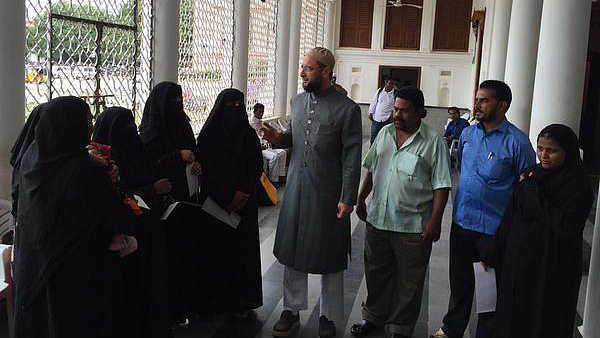With just a month left for the elections, battle lines are being drawn on Bihar’s electoral chess board. As of now, Mandal and Kamandal are evenly poised; Mandal is a metaphor for empowerment of OBCs while Kamandal is a derogative term coined by OBC politicians like Lalu Prasad Yadav to poke fun at BJP’s “communal” politics. In the highly Mandalised state, the BJP has never been able to form a government on its own and it crawled to power in 2010 piggybacking Nitish Kumar. Will November 8 change this narrative?
In the no-holds-barred battle, which has much at stake for Prime Minister Narendra Modi and BJP president Amit Shah in particular, the saffron party managers are leaving nothing to chances. As part of a smart move, the BJP is trying to play the “development” card outwardly while plotting strategies to beat the solid JDU-RJD-Congress caste arithmetic bolstered by the minority vote bank.
The ‘MY’ Factor
BJP’s indirect wild cards, if at all they are, to split the “MY” (17% Muslims and 14% Yadav) citadel are Samajwadi Party chief Mulayam Singh and All-India Majlis-e-Ittehadul chief Asaduddin Owaisi. They could, even if by default, emerge as the saviours of BJP, if the MY bastion is breached when ballot boxes are opened.
Since the minority community is unlikely to vote for the BJP, the NDA strategy is to split their votes in the secular camp. It managed to isolate Mulayam Singh from Nitish-Lalu-Congress alliance and according to Bihar observers, is now egging on the SP chief to field a good number of Yadav and Muslim candidates to scatter JD(U)-RJD-Congress votes.
Though the SP has been contesting Bihar polls since 1990, it has never been able to garner more than one per cent of the votes and yet the party is contesting all the 243 seats. Mulayam’s grand entry comes in the wake of reports that RJD rebel and muscle man Pappu Yadav, now backing BJP, may not be able to make substantial inroads into the Yadav base.
Split Strategy
- Mulayam and Owaisi emerge as BJP’s not-so-obvious wild card that can split the traditional Muslim and Yadav vote bank
- NDA is banking on Mulayam to field a good number of Yadav and Muslim candidates to split JD(U)-RJD-Congress votes
- AIMIM is BJP’s best bet, not only to split the Muslim votes, but also to effect a reverse communal polarisation
- BJP has stitched up a good caste alliance with Upendra Kushwaha, Jitan Ram Manjhi and Ramvilas Paswan, the trio along with the BJP having a support base of 41% of the electorate
- JD(U)-RJD-Congress front commands 35% support base belonging to Lalu Yadav and Nitish Kumar
AIMIM’s Foray: Advantage BJP
Mulayam is in talks with NCP chief Sharad Pawar and its Bihar leader Tariq Anwar for setting up a fourth front in the state, the third being the CPM, CPI, CPI(ML) and a few other splinter left parties. The SP chief is also mulling a proposal to project Tariq Anwar as the combine’s chief ministerial candidate; an ostensible bait for wary Muslim voters. The NCP, which is supporting BJP-led government in Maharashtra from outside, though is inconsequential in Bihar plans to contest over 20 seats.
The AIMIM is the best bet for the BJP not only to split the Muslim votes but to effect a reverse communal polarisation. The firebrand All-India Majlis-e-Ittehadul chief Asaduddin Owaisi, who speaks the language of VHP and Bajrang Dal hotheads, could create a wedge between communities, if he indulges in hate speech, to the BJP’s advantage. Union commerce minister Nirmala Sitharaman has gone on record, in an interview to Indian Express, saying that MIM is good for the BJP.
Owaisi Factor
Owaisi has declared that his party will contest the polls in Purnia, Katihar, Araria and Kishanganj, the epicentre of Muslim politics. The four districts have between 40 and 60% Muslim population. The import from Hyderabad may not set the Kosi on fire, but by nibbling at the Muslim votes he could weaken the JD(U)-RJD-Congress camp in about two dozen seats.
Not banking on development alone, the BJP has managed to stitch up a good caste alliance with leaders such as Upendra Kushwaha (representing four per cent Kushawahas), Jitin Ram Manjhi (leader of 10 per cent Mahadalit community) and Ramvilas Paswan, leader of 6% dalits and six percent telis, an OBC caste, akin to Narendra Modi’s Ghanchi community in Gujarat. That makes it 41%.
Shrinking Support Base of JD(U)-RJD-Congress Front
As against this, the JD(U)-RJD-Congress front commands 35% support base – 14% Yadavs (fellow caste men of Lalu Prasad) and the 17% Muslims and 4% Kurmis [JD(U) chief’s Nitish Kumar’s community]. Kurmis are numerically small and difficult to crack and hence the saffron strategists have turned their attention to the Muslims and Yadavs.
Apart from these two main groupings, eight per cent OBC Koeris and 24% EBCs are up for grabs and the electoral outcome will depend much on their behaviour as well on the D-day. Since the last decade, the BJP, courtesy the RSS, has been able, to some extent, quietly penetrate Bihar’s social fabric, but to what scope and degree will be known on November 8.
(The writer is a Delhi-based senior journalist)
(At The Quint, we question everything. Play an active role in shaping our journalism by becoming a member today.)
